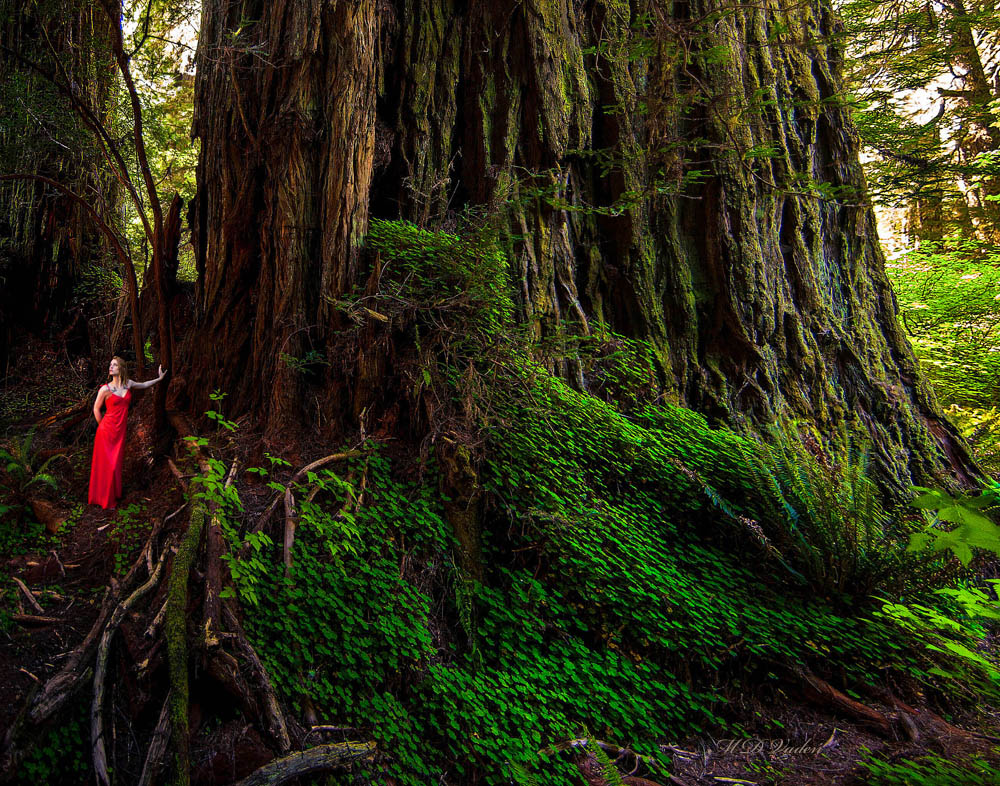When discovered by Dr. Steve Sillett and Michael Taylor in May, 1998, the trunk's preliminary measure was close to 26' diameter @ dbh. A scientific study reported 25.26' diameter dbh which seems to exclude an extra trunk. Lost Monarch's lowest twigs almost touch the ground which is very unusual among the largest coast redwoods. The crown of branches and foliage stretches about 320 ft. top to bottom, and in that regard, surpasses the foliage and branch crown of Hyperion or Redwood Creek Giant, two of the tallest known coast redwoods. The new discovery redwood I linked to previous has almost as much foliage and branch height.
The 2nd photo below shows a bright gap of sky and space between the large stem and another redwood stem. When I reviewed the April 2012 photo again, it really hit home how correct Van Pelt was when he referred to the big sprout as a second redwood. In the same grove, Del Norte Titan formed from three stems becoming a huge triple fusion where the air gaps and included bark vanished from sight leaving inconspicuous clues that hardly anybody will notice. When all these measurements and visual evidence are considered together, it has me suspecting Lost Monarch to be the 2nd oldest redwood in the grove. I think its main stem is a single trunk (skipping the adjacent stems). And I think it has better access to water than El Viejo del Norte. So even though El Viejo has a more narrow trunk, I think El Viejo is older and grew less "meat on its bones" each year over the centuries.
Michael Taylor, co-discoverer, noted the sprout (s) account for at least 6,000 cu. ft.. When only the main trunk and its reiterated wood overhead are included, the real volume is closer to 36,500 cu. ft.. Measurements by researchers showed the main trunk's actual volume between 34,000 and 35,000 cu. ft. Regardless, this is an exceptionally old and remarkable coast redwood. Some people tout the wood volume at 42,500 cubic feet by adding 6,000 cu. ft. from a separate basal redwood emerging at ground level, but that's a fantasy when it comes to facts. We can see it in the photos. There's actually several sucker redwoods shown.
There's been scuttlebutt that Dr. Steve Sillett observed branches in the crown above 200 feet being killed by forest fire in the past and that new branches sprouted from the main stem. If that were true, it would connote the existing crown came from epicormic sprouts. But I recall asking Sillett, and he said that's not exactly the story behind Lost Monarch's shape and crown.
There are over 40 reiterated stems overhead accounting for about 400 cu. ft. The diameter of the largest single branch is 3.2 ft.. Hefty indeed, but smaller than the largest branch diameter of Chesty Puller redwood in the same grove. Again, this shows how much interesting individuality belongs to each giant coast redwood in this grove.
The base of the redwood on the ground is nearly 30' wide. Researcher Dr. Robert Van Pelt described it as "vaulting" out of the earth like a "volcano". Some of the roots are visible almost 100 feet away in boggy soil nearby. Van Pelt also wrote that a couple of limbs extend almost 70 feet. Thats intriguing because on American Forests champion list, Lost Monarch's average entire crown width was 80 feet from side to side. It may remain on the American Forest champion list for quite some time, because there are multiple larger new redwood discoveries we will not be nominating. Supposedly, champs on the list should be measured every 10 years, but I do not think that's going to happen for Lost Monarch. But AF will probably keep it listed rather than leave a void.
This has been a challenging redwood to photograph. Thick vegetation blocks the view from almost every side as far as the base goes. My first encounter with Lost Monarch spent more time photographing British Soldier lichens on the trunk. The lichens were fascinating. I encountered one the largest organisms on earth with a little army of lichens marching up the trunk. I was so distracted by the lichens I walked away without realzing this was Lost Monarch, until several months later. That was back in 2008 when hardly anybody knew where this redwood was located and there were zero social trails.
Image: the photo below was taken April Fools Day, 2012. The gap of separation between the trunks is easy to spot about 25 ft. to 30 ft. up. Related to redwoods merging trunks and stems. see the related page Fusion vs. Confusion.

The next photo below was taken on October 4, 2008. Looking across a marsh that author Richard Preston described as a grassy glade. This view is framed by bigleaf maple on the left, coast redwood on the right, and vine maples below. You can see a hint of red autumn leaves on a few of the vine maples. The gap between the trunks is even more evident in this image.





